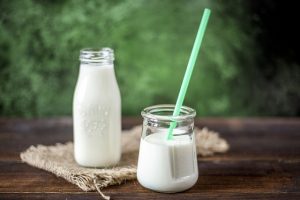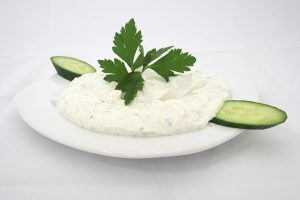What is dairy?
Butter, buttermilk, cheese(s), yogurt, milks, cream
Quality Goals: Grass-fed/finished, organic, whole/full-fat
Grass-fed
Benefits:
 Healthier for the animal to eat what it gets in nature, that includes beneficial bugs in the grass.
Healthier for the animal to eat what it gets in nature, that includes beneficial bugs in the grass.- We do better when we eat grasses/greens versus grains, corn, and soy, so do other animals.
- Corn and soy can be GMO sources
- Animals may need antibiotics or other digestive aids if they are given a diet that doesn’t agree with their digestive system.
Cautions:
- Now a popular marketing term as marketers recognizes that consumers will choose grass-fed.
- Does not mean organic; does not mean exclusively grass-fed, doesn’t mean no antibiotics or hormones.
- TIP: Choose 100% grass-fed
Organic
- Doesn’t mean not processed or pasteurized.
- Contains better fat profile – more of omegas, less saturated, more CLA.
- Reduce risk of toxins (pesticides, industrial toxins) accumulate in fat in animals so when you consume dairy fat you are more likely to consume those toxins stored in the fat of the animal.
Full Fat
- Less processed, fewer replacement ingredients to produce desired mouthfeel, consistency.
- Intended hormonal impact versus altered impact – the hormone impact of dairy changes when the fat is removed.
- Key nutrients are the fats (omegas, CLA) and others are fat-soluble (Vitamin A, D,E,K)
Raw vs Pasteurized vs Ultra
- Raw dairy can be an excellent source of nutrients; risks associated with production and storage, get from a reputable source.
- Pasteurization – reduces the presence of bacteria (“Heating the milk removes 99.9% of the bacteria in the milk”) for safety and shelf life. But out with the bad bacteria (potentially harmful, and those that induce spoilage) go good bacteria (probiotics) too; pasteurization may alter the flavor and additional nutrient profile. HTST vs Ultra are both types of pasteurization used in the USA.
- Get Cultured – fermented dairy provides probiotics (good bacteria) and often make the dairy easier to digest. This is different than processed dairy products with added probiotics that may not even include bacteria strains native to dairy.
Nutrient Balance
- All Dairy Does Not Deliver the Same Macro Nutrient
- Some are a good source of carbohydrate and protein and fat
- Some are a good source of protein and fat
- Some are carbohydrate and fat with minimal or no protein
- Some are just fat
- Know the difference in your dairy choice to help you nutrient balance your nutrition pit stop
Quality & Frequency
Accessorize with Dairy
- Practice proper portions (see my workbook, The Better Nutrition Plan)
- While there are ways to do dairy right, Better Dairy Nutrition = enjoy smaller amounts, less often
- Consume with foods that support the body’s detoxification and elimination (i.e. grains, seeds, greens, broccoli)
- Choose plant sources of fats and proteins more often
What Animal Makes Better Dairy
 “Are we allergic/intolerant to foods or what’s been done to them?” my friend Robyn O’Brien poses this question; it is so true, and true of what we have done to the animals.
“Are we allergic/intolerant to foods or what’s been done to them?” my friend Robyn O’Brien poses this question; it is so true, and true of what we have done to the animals.
- Cow’s milk dairy is considered (lactose point below) the most likely to be an allergen or intolerance;
- The quality of the cow’s dairy will impact
- Organic, grass-fed, raw or cultured best options
- Goat & Sheep tend to be better tolerated. May be a good option for lactose intolerant – Organic
- Camel, buffalo etc are interesting “new” dairy sources now available that have history of consumed in other parts of the world
- Watch added sugars
- Avoid highly processed
- Organic, raw
Myth Bust
1. Rich in nutrients. Dairy can provide nutrients, and quality dairy can be a good source of nutrients as described above, but all of those nutrients can be consumed in other foods or in quality supplements, especially if dairy is contraindicated (per the below) or not tolerated
2. Need dairy for calcium. First, not all dairy is even a good source of calcium. Second, calcium is found in a variety of plants making the “I need dairy for calcium” argument actually a marketing one from dairy makers not a health practitioners truth.
3. Calms the tummy & helps you fall asleep. Many people still turn to dairy before bed or when their tummy hurts from having been raised on these “truths”. Well, the opposite is actually true. While cultured raw organic grass-fed dairy could help the digestive system over time, I wouldn’t recommend it before bed, milk is a sugar and that will provide energy and require digestion – both are the opposite of what we want our body or minds to get before bed. Instead of dairy, I recommend breath work (the 4-7-8 breath is in through nose for 4 sec, hold for 7 sec, out through mouth for 8 seconds, repeat 10 times) to calm anxiety; for acid irritation, I recommend taking deglycyrrhizinated licorice (DGL) or an organic acid calm tea or digestive enzymes, as well as not eating within 2 hours of lying down, skipping bubbly beverages of all kinds, and sleeping with your head and upper chest raised. As for better sleep, falling asleep and staying asleep, the mineral you want is magnesium, not extra calcium, to help the body (and mind) relax.
4. Good source of vitamin D. The source of vitamin D in most dairy is actually from fortification (added) as opposed to foods like wild salmon (and wild salmon fish oils) that naturally contain vitamin D3. You would actually need to drink eight glasses of milk to get your daily dose of vitamin D! Cheese contains a little amount of vitamin D3 and mushrooms are a source of vitamin D2. Vitamin D is a fat-soluble vitamin so there goes the argument for fat-free dairy fortified with vitamin D. Because vitamin D is actually a hormone and so critical to optimal health, I recommend a daily supplement or as otherwise prescribed by your healthcare provider along with their (ideally) twice a year or more frequent assessment of your levels. Digestive health and inappropriate inflammation will impact your ability to absorb vitamin D also.
5. Lactose intolerance?? Many many people do not digest dairy but it may not be the lactose that’s the sole or primary issue. The protein balance of dairy has changed over the decades (used to more closely resemble other animals whose dairy is less of a tolerance issue) and today we are learning about this change – along with how the proteins and enzymes change with high heat – that make impact how people tolerate dairy. For those that are lactose intolerant, it can range in severity and there are dairy products that remove the lactose (lactose-free) to enable them to consume dairy. There is a problem, however, as its even more critical if something irritates your system that you only consume better quality dairy – which a lot of the lactose-free dairy is not– as well as because that dairy is less irritating to the lactose intolerant patient, they often consume it without high regard to quantity and frequency.
Contraindications
If you are going to dairy, dairy right… and for the following that means not having dairy for a time period or at all:
- Digestive issues – gas, bloating, constipation, diarrhea, reflux
- Sinus issues – during a sinus challenge or not at all for someone who experiences frequent sinus issues
- Cold – dairy is not a food used for healing
- Sore throat – no ice cream is not the treatment for sore throats; actually go with hot tea and raw honey instead
- Auto-immune disease – dairy is contraindicate for anyone with issues related to inappropriate inflammatory response like auto-immune diseases; however, you may find that your doctor or dietitian recommends bovine colostrum as part of healing the digestive tract lining
- Heart disease – especially risk factors related to arterial plaque or inappropriate inflammatory response
- Hormone imbalance –as discussed above, dairy does impact hormones
- Skin issues – from hormonal and digestive concerns as well as inappropriate inflammatory response concerns
Better Dairy Nutrition Pit Stop Advice
 If you put milk or cream in your coffee daily, make certain it is quality and note that anything above a “splash” (1 ounce) counts toward your nutrient intake at that pit stop. Try a cortado or small cappuccino versus a venti latte even if the milk is organic whole. 6.75 ounces will be your carb, protein, and fat (10g, 7g, 7g) so enjoy it solo or with some veggies but not with a muffin or a fruit. For those that want to consume more protein, consider having an egg or wild salmon jerky.
If you put milk or cream in your coffee daily, make certain it is quality and note that anything above a “splash” (1 ounce) counts toward your nutrient intake at that pit stop. Try a cortado or small cappuccino versus a venti latte even if the milk is organic whole. 6.75 ounces will be your carb, protein, and fat (10g, 7g, 7g) so enjoy it solo or with some veggies but not with a muffin or a fruit. For those that want to consume more protein, consider having an egg or wild salmon jerky.
If you are having a yogurt, the nutrient balance ranges considerably. I advise plain yogurt – it can make a grneat dip when you blend it with spices and dip in organic veggies (you can use organic kefir or lemon juice instead of the buttermilk) – but skip the fruit added yogurts and if you do top a yogurt with fruit choose organic berries which are lower in sugar and you can keep a portion to 1⁄2 cup – this is best on organic plain Greek yogurt which is lower in total carbohydrate naturally.
Originally printed on ashleykoffapproved.com. Reprinted with permission.
Ashley Koff RD is your better health enabler. For decades, Koff has helped thousands get and keep better health by learning to make their better not perfect nutrition choices more often. A go-to nutrition expert for the country’s leading doctors, media, companies and non-profit organizations, Koff regularly shares her Better Nutrition message with millions on national and local television, magazines and newspapers. Visit her website at ashleykoffapproved.com. Ashley is also available for nutritional consultations.
